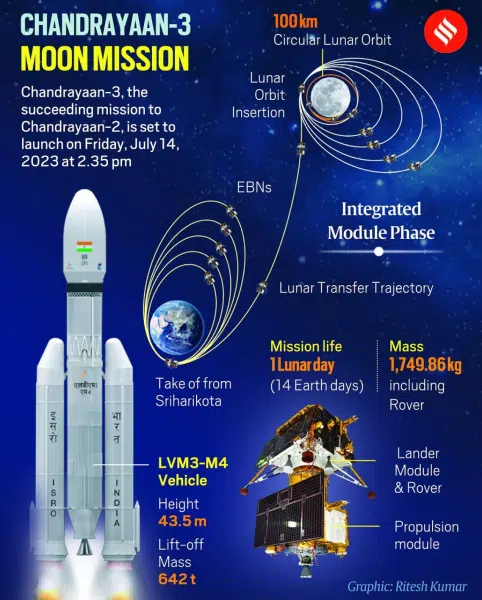
What is Chandrayaan-3 Mission?
Chandrayaan-3 is India’s third moon mission and is a follow-up of Chandrayaan-2 (2019) which aimed to land a rover on the lunar South Pole. The Mission will have three major modules- the
- Propulsion module ( will carry the lander and rover configuration till 100 km lunar orbit)
- Lander module (capability to soft land and deploy Rover)
- Rover (will carry out in-situ chemical analysis of the lunar surface)
Challenges of landing on the South Pole:
Previous spacecraft have mostly landed near the equatorial region of the Moon, a few degrees latitude north or south of the lunar equator. Landing near the equator is easier and safer due to the hospitable terrain, smooth surface, absence of steep slopes, and ample sunlight for solar-powered instruments.
The lunar south pole, on the other hand, presents a challenging terrain with extreme temperatures and areas that are in permanent shadow, receiving no sunlight.
Why ISRO wants to explore the Moon’s south pole?
- Water Resources: The south pole region is believed to have water molecules in substantial amounts, possibly trapped as ice in the permanently shadowed craters.
- Exploring and confirming the presence of water is essential for future human missions and the potential utilization of lunar resources.
- Scientific Discoveries: The extreme environment and the presence of permanently shadowed regions provide a preserved record of the Moon’s history and the early Solar System.
- Clues to Earth’s History: The Moon is thought to have formed from debris generated by a giant impact between a Mars-sized object and the early Earth.
- By studying the lunar south pole, scientists can gain insights into the materials and conditions that existed during the formation of the Earth-Moon system.
- Global Collaborations: ISRO-NASA successfully confirmed the presence of water from the data taken by Chandrayaan-1. Indo-Japan collaboration, LUPEX aims to send a lander and rover to the Moon’s south pole around 2024.
- Technological Advancements: By undertaking missions to this region, ISRO can develop and demonstrate innovative technologies for soft landing, navigation, resource utilization, and long-duration operations that can be applied in future space missions.
Comparision of Chandrayaan-1, 2 and 3
| Mission | Chandrayaan-1 | Chandrayaan-2 | Chandrayaan-3 |
| Launch Year | 2008 | 2019 | Scheduled for 2023 |
| Objectives | Study lunar surface | Study the lunar surface and land rover on the lunar South Pole | Demonstrate landing capabilities for Lunar Polar Exploration Mission |
| Components | Orbiter, Moon Impact Probe | Orbiter, Lander (Vikram), Rover (Pragyan) | Propulsion module, Lander, Rover |
| Findings | Confirmed presence of lunar water, lunar caves, tectonic activity, faults, and fractures | Building on the evidence of water molecules shown by Chandrayaan-1 | – |
| Communication | Communication issues after 312 days of operation | Lander crash-landed, rover unable to operate | – |
| Launch Vehicle | PSLV | GSLV-Mk 3 | LVM3 |
| Landing Site | – | Lunar South Pole | Lunar South Pole |
| Major Partners | – | – | Japan (for Lunar Polar Exploration Mission) |
About LVM3:
Launch Vehicle Mark 3 (LVM3) (previously known as GSLV-MK III) is a three-stage launch vehicle consisting of two solid propellants S200 strap-ons on its sides and a core stage comprising L110 liquid stage and C25 cryogenic stage. The vehicle is also dubbed as one of the heaviest for its ability to carry satellites up to 8,000 kg.

